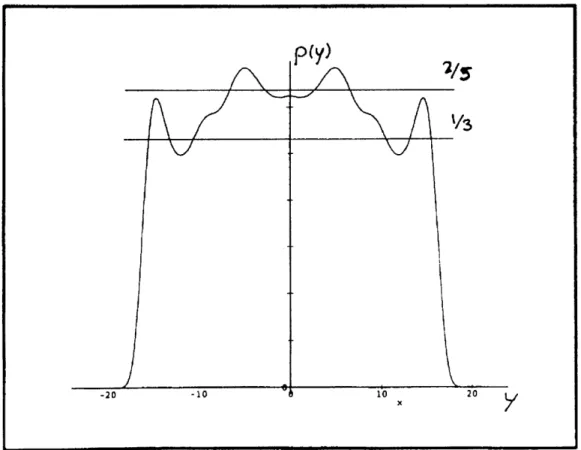Chapter 3. Edge Structure Of A Quantum Dot
Chapter 3. Edge Structure Of A Quantum Dot
In
A Large
Magnetic Field
Academic and Research Staff
Professor Patrick A. Lee, Dr. Konstantin Matveev Graduate Students
Dmitri Chklovskii
Technical and Support Staff Imadiel Ariel
3.1 Project Description
Sponsor
Joint Services Electronics Program Contract DAAL03-92-C-0001
Two years ago, Professor Raymond Ashoori dem-onstrated that it is possible to tunnel a single elec-tron on and off a quantum dot and map out the energy level structures of the first five or ten elec-trons.1 This experiment was also done in a mag-netic field so that the spectrum can be monitored as the field is varied.2 In the future, it is expected that the magnetic field can be increased so that one can enter the fractional quantum hall effect (FQHE) regime, i.e., when only the lowest Landau level is occupied. It is then important to theoretically study what is the expected behavior for the tunneling onto a quantum dot in the FQHE limit.
We addressed this problem two years ago, assuming that the electrons are confined by a rapidly varying potential. We found a strong sup-pression of the tunneling amplitude due to many-body effects, and novel features such as alternating strong and weak tunneling amplitude with increasing electron numbers in the case of the 2/3 filled Landau level.3 However, in practice the
con-fining potential is produced by gates relatively far away, so that the confining potential is slowly varying. In the past year, we initiated a project to study the behavior of the edge of the quantum dot in the case of a slowly varying potential. It is important to understand the edge structure because tunneling occurs predominantly at the edge.
Traditionally, the FQHE is understood in terms of the Laughlin wavefunction, which describes an incompressible electron state at special filling factors. Recently, it has been suggested that a par-tially filled Landau level may be described by making a transformation to composite fermions.4 This is achieved by attaching two magnetic field flux quanta to each electron. The theory explains several experimental observations, and its predic-tions were recently experimentally confirmed. We use the composite fermion approach to study an experimentally relevant system where electrons are confined to a quantum wire or a quantum dot. We solve for the electron wavefunction by multi-plying it with a Jastrow-like function. Figure 1 dem-onstrates the good agreement between our calculations and the results obtained from the Laughlin wavefunction by Rezayi and Haldane. However, their study was limited to simple fractions and few electron systems.
1 R.C. Ashoori et al., "Single-electron Capacitance Spectroscopy of Discrete Quantum Levels," Phys. Rev. Lett. 68: 3088 (1992).
2 R.C. Ashoori et. al., "N-Electron Ground State Energies in a Quantum Dot in Magnetic Field," Phys. Rev. Lett. 71: 613 (1992).
3 J. Kinaret, P.A. Lee, Y. Meir, X.G. Wen, and N. Wingreen, "Conductance Through a Quantum Dot in the Fractional Quantum Hall Regime," Phys. Rev. B. 45: 9484 (1992).
Chapter 3. Edge Structure Of A Quantum Dot
Figure 1. Density profile for the 1/3 quantum Hall state. Dashed line: Rezayi-Haldane calculations for the Laughlin wavefunction. Full line: Our composite fermion Hartree calculation. Length is measured in magnetic length units. Unit corresponds to a completely filled Landau level.
We are able to extend our calculations to other fractional states and greater number of electrons. This allows us to perform the first systematic study of the fractional edge states. We find that the frac-tional edge states can be described very naturally in the composite fermion representation as the integer edge states and the snake states. We can predict the number of fractional edge states formed in a given confinement scheme as well as the density distribution (see figure 2). These results are crucial for the explanation edge magnetoplasmon experiments in mesoscopic devices. The results are also the starting point for a theory of tunneling onto the quantum dot in the FQHE regime.
3.2 Publications
Lee, P.A. "Few Electron Nanostructures: A New Laboratory for Studying Strongly Correlated Systems." Proceedings of the NATO Workshop, Noordevijk, the Netherlands, September 1992,
Physica B 189: 1 (1993).
Meir, Y., N. Wingreen, and P.A. Lee. "Low Temper-ature Transport Through a Quantum Dot: The Anderson Model Out of Equilibrium." Phys. Rev. Lett. 70: 2601 (1993).
58 RLE Progress Report Number 136
0 10
Chapter 3. Edge Structure Of A Quantum Dot
Figure 2. Density profile for the 2/5 state (composite fermion Hartree calculation). Despite the ripples reflecting the density-density correlation function one can see that 2/5 state goes through a 1/3 state before entering the vacuum.
_
Professor Henry I. Smith

